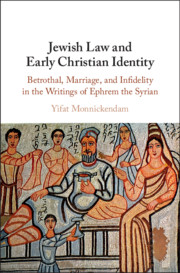 Jewish Law and Early Christian Identity
Jewish Law and Early Christian Identity Book contents
- Jewish Law and Early Christian Identity
- Jewish Law and Early Christian Identity
- Copyright page
- Dedication
- Contents
- Acknowledgments
- Introduction
- Chapter 1 Creating a Primary Bond
- Chapter 2 During Betrothal
- Chapter 3 Creating a Marital Bond
- Chapter 4 Breaking a Marital Bond
- Chapter 5 Discussion and Conclusions
- Bibliography
- Index Locorum
- Index
Chapter 1 - Creating a Primary Bond
What Is Betrothal?
Published online by Cambridge University Press: 12 December 2019
- Jewish Law and Early Christian Identity
- Jewish Law and Early Christian Identity
- Copyright page
- Dedication
- Contents
- Acknowledgments
- Introduction
- Chapter 1 Creating a Primary Bond
- Chapter 2 During Betrothal
- Chapter 3 Creating a Marital Bond
- Chapter 4 Breaking a Marital Bond
- Chapter 5 Discussion and Conclusions
- Bibliography
- Index Locorum
- Index
Summary
Had Ephrem been asked to directly compare betrothal to marriage, he would have probably replied, as would many Christians of his time: “A man’s betrothed is his wife,” thus claiming that betrothal equates to marriage. In fact, as we will see, Ephrem repeated this statement, along with two variants, several times in his biblical commentary and in his hymns, using it either as a solution to an exegetical problem or as part of a theological discussion. In these cases, he focused on the linguistic aspect of this claim: a man’s betrothed is called a man’s wife. Should Ephrem’s assertion that a man’s betrothed is his wife be regarded purely as a linguistic claim that may serve either a local exegetical need or theological need, or does this claim have a wider context? If so, what is the wider context that influenced it? On the one hand, this statement can be discussed as a legal statement, and as a source reflecting Ephrem’s view on the status of betrothal versus the status of marriage. It may be addressing the question of whether betrothal, the intermediate stage between bachelorhood and marriage, is legally closer to one or the other, and the legal implications thereof. On the other hand, it can be discussed as an exegetical or theological statement, and therefore it could reflect Ephrem’s theological and exegetical discourse, regardless of his legal views.
- Type
- Chapter
- Information
- Jewish Law and Early Christian IdentityBetrothal, Marriage, and Infidelity in the Writings of Ephrem the Syrian, pp. 45 - 86Publisher: Cambridge University PressPrint publication year: 2020


